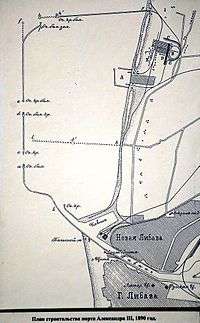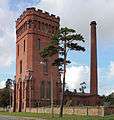Karosta
Karosta is a former Russian Imperial and Soviet naval base on the Baltic Sea, which today is a neighbourhood in Liepāja, Latvia.

History
The naval base was originally constructed in 1890-1906 for Tsar Alexander III of Russia, and named Порт Императора Александра III.[1] Built on the bare coast it consisted of a large man-made harbour including a large breakwater and inland submarine base.
During Lavian independence after World War I, the base was called Kara osta (War Port in Latvian), later shortened to Karaosta and Karosta (Кароста in Russian).[2]
It was a closed military area and army town during the Soviet period, serving as a base for the Soviet Baltic Fleet. It was inaccessible to the civilians of neighbouring Liepāja.[3]
When the Soviet Union army left Latvia in 1994 after the restoration of Latvian independence, Karosta became largely uninhabited and most structures fell to ruin. In late 1990s, the area was troubled by high unemployment, street crime and drug problems. It is today a neighbourhood in the northern outskirts of Liepāja in Latvia, occupying a third of the area of the city.[4]
Today
Now it is a very popular place for tourists and artists, since there are unique sights and interesting places, such as the scenic seascapes with partially blasted fortresses on the Baltic shore. The K@2 Artists` center was established in 2000 and acts as a frame for many cultural activities by local and foreign artists who come to Karosta to make their projects and get inspiration from the unique feeling that only Karosta has - nature, buildings, ruins, people.
The army headquarters include czar-era mansions used by admirals, a palace for the czar (reportedly only used once), an impressive Russian Orthodox Naval Cathedral, as well as underground bunkers and abandoned storehouses. Soviet-era buildings include many rows of block housing. At its height Karosta was home to over 20,000 people.
Karosta military prison has now been converted into a museum (open May - September) and it is possible to spend the night in the guardhouse processed as a prisoner would have been.
Gallery
.jpg) Khrushchyovka and the Naval Cathedral
Khrushchyovka and the Naval Cathedral Karosta's shores are littered with abandoned fortifications from Tsarist Russia
Karosta's shores are littered with abandoned fortifications from Tsarist Russia- St. Nicholas Orthodox Naval Cathedral (1901–1903)
 The old water tower
The old water tower_(2).jpg) The first battery of the north forts
The first battery of the north forts.jpg) Ruins of the Northern forts
Ruins of the Northern forts- Ruins of the riding arena
- Kalpaka bridge, connects Karosta with other parts of Liepāja
 Soviet blockhouses in Karosta
Soviet blockhouses in Karosta
In culture
In 2008 Ivory Tower Pictures produced a television documentary called Karosta: Life After the USSR directed by Peter King.
References
- Russian text from Sankt Petersburg, 1895
- 100 gadi 100 kartēs, ISBN 978-9984-07-746-8, page 22
- Liepāja Naval Port
- Liepāja Naval Port
External links
| Wikimedia Commons has media related to Karosta. |
| Wikivoyage has a travel guide for Liepaja. |